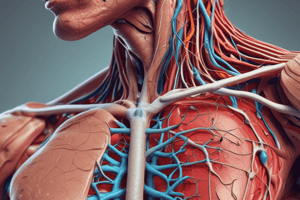Podcast
Questions and Answers
Which cranial condition is characterized by an abnormal accumulation of cerebrospinal fluid leading to increased head size?
Which cranial condition is characterized by an abnormal accumulation of cerebrospinal fluid leading to increased head size?
- Hydrocephalus (correct)
- Torticollis
- Paget’s disease
- Acromegaly
What is a possible symptom indicating issues with the neck that could warrant further medical examination?
What is a possible symptom indicating issues with the neck that could warrant further medical examination?
- Head injury
- Mood swings
- Concave cervical curve (correct)
- Increased appetite
Which lymphatic region is located under the jawline?
Which lymphatic region is located under the jawline?
- Submandibular (correct)
- Postauricular
- Tonsillar
- Occipital
What physical examination technique is used to check the size and shape of the skull?
What physical examination technique is used to check the size and shape of the skull?
Which of the following terms refers to a common muscular disorder characterized by a twisted neck?
Which of the following terms refers to a common muscular disorder characterized by a twisted neck?
What symptom might suggest a problem with the thyroid gland during a physical examination?
What symptom might suggest a problem with the thyroid gland during a physical examination?
Which facial muscle is primarily responsible for facial expressions?
Which facial muscle is primarily responsible for facial expressions?
What would likely indicate abnormalities in the cervical lymph nodes during a physical exam?
What would likely indicate abnormalities in the cervical lymph nodes during a physical exam?
Which abnormality is associated with an enlarged parotid gland?
Which abnormality is associated with an enlarged parotid gland?
During a health history assessment, which of the following would be considered a subjective symptom?
During a health history assessment, which of the following would be considered a subjective symptom?
Flashcards are hidden until you start studying
Study Notes
Head Structure and Function
- Cranial bones protect the brain, forming the skull.
- Sutures are the fibrous joints connecting cranial bones.
- Facial bones contribute to facial structure and support.
- Facial muscles are essential for expressions and movement.
- Salivary glands produce saliva for digestion and maintain oral health.
Neck Structure and Function
- The neck contains crucial muscles supporting head movement.
- Anterior and posterior triangles divide the neck into distinct regions for anatomical reference.
- The thyroid gland regulates metabolism through hormone production.
Lymphatics Structure and Function
- Key lymphatic regions include:
- Preauricular lymph nodes located in front of the ear.
- Posterior auricular (mastoid) lymph nodes behind the ear.
- Occipital lymph nodes located at the base of the skull.
- Submental lymph nodes beneath the chin.
- Submandibular lymph nodes found beneath the jaw.
- Tonsillar lymph nodes near the tonsils.
- Superficial cervical lymph nodes in the superficial tissues of the neck.
- Deep cervical lymph nodes located under the sternocleidomastoid muscle.
- Posterior cervical lymph nodes posterior to the sternocleidomastoid.
- Supraclavicular lymph nodes above the clavicle.
Developmental Considerations
- Older adults may experience sagging facial skin.
- Common issues include senile tremors and concave cervical curve.
- Dizziness can occur with range of motion limitations.
Subjective Data: Health History
- Common complaints include headaches, head injuries, and dizziness.
- Neck pain or motion limitations may indicate underlying issues.
- Lumps or swelling warrant further investigation.
- A history of head or neck surgery can influence current health status.
Objective Data: Physical Exam – Head
- Inspection and palpation of the skull assess size and shape, typically normocephalic.
- Examination of the temporal area involves evaluation of the temporal artery and temporomandibular joint (TMJ).
- Facial structure inspection assesses symmetry and anomalies.
Objective Data: Physical Exam – Neck
- Symmetry and range of motion are assessed for any abnormalities.
- Lymph nodes, if palpable, are evaluated for location, size, shape, delimitation, mobility, consistency, and tenderness.
- Palpation of the trachea and thyroid gland is conducted via posterior and anterior approaches.
- Auscultation is performed for potential bruit over the thyroid.
Abnormal Findings
- Abnormal head size or contour may suggest:
- Hydrocephalus—accumulation of cerebrospinal fluid.
- Paget’s disease of bone—disordered bone remodeling.
- Acromegaly—excessive growth hormone resulting in enlarged features.
- Swelling of head and neck can indicate:
- Torticollis (wryneck)—twisting of the neck.
- Thyroid issues, such as multiple nodules.
- Pilar cysts (wen)—benign cystic growths.
- Parotid gland enlargement—may relate to infection or other conditions.
Studying That Suits You
Use AI to generate personalized quizzes and flashcards to suit your learning preferences.




